Tag Archives: Next Billion Users
Bringing more people online and introducing Camera Go
There are more than 3.5 billion people who use smartphones, but that’s only 45 percent of the world’s population. We created Android (Go edition) to bring more affordable, high-quality smartphones to people around the world. Thanks to our partners who have made more than 1,600 device models available in 180+ countries, there are now more than 100 million active Android (Go edition) devices around the world. Here are some updates on Go edition’s progress and where we’re going next.
Powering universal access to information
In partnership with Safaricom, Kenya’s largest telecom provider, we brought more than 900,000 Android (Go edition) smartphones to people in Kenya—53 percent of whom were women—through their “Life is Digital” campaign. This is especially important because there is a significant gender gap in mobile internet usage in Sub-Saharan Africa.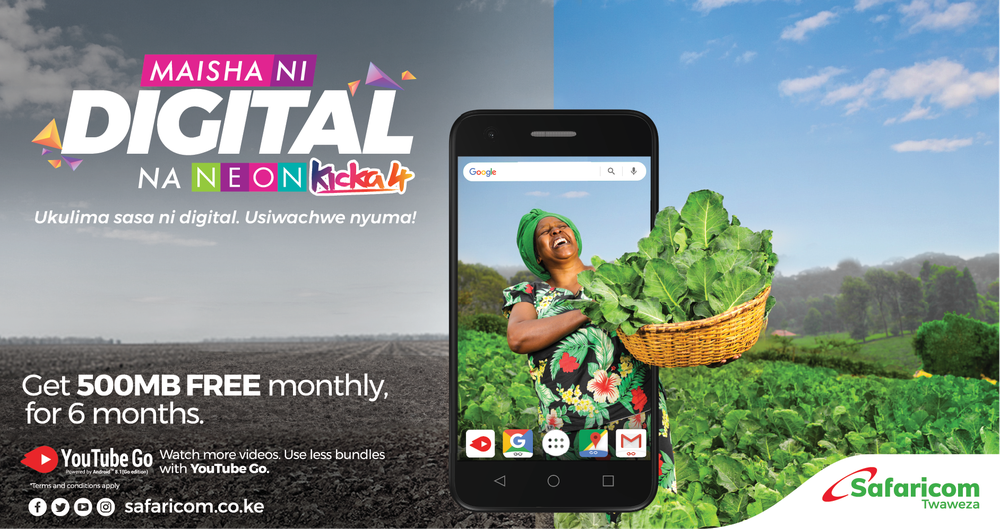
With the help of the suite of Google apps designed for Go edition, people are connecting with new opportunities and making gains in their daily lives. For example, Google Go has helped connect millions of people to information by providing a lightweight search engine that works on unstable connections. And with Lens in Google Go, people can quickly translate, hear and search text they see in the real world using their phone camera—helping them understand words on street signs, medicine labels, documents, and more.
Across the Google apps designed for Android (Go edition), we’ve introduced a number of user privacy features to protect the next billion people coming online for the first time. For example, a new mode within Google Go lets people search without their searches being saved to their account, and Gallery Go leverages on-device machine learning to help people organize photos without ever sending data to the cloud.
Bringing a beautiful, fast camera experience to affordable devices
Your phone’s camera gives you the power to capture memories that you’ll want to share with those around you. But on many smartphones, camera apps are often slow or complex to use, and your phone can quickly run out of storage.
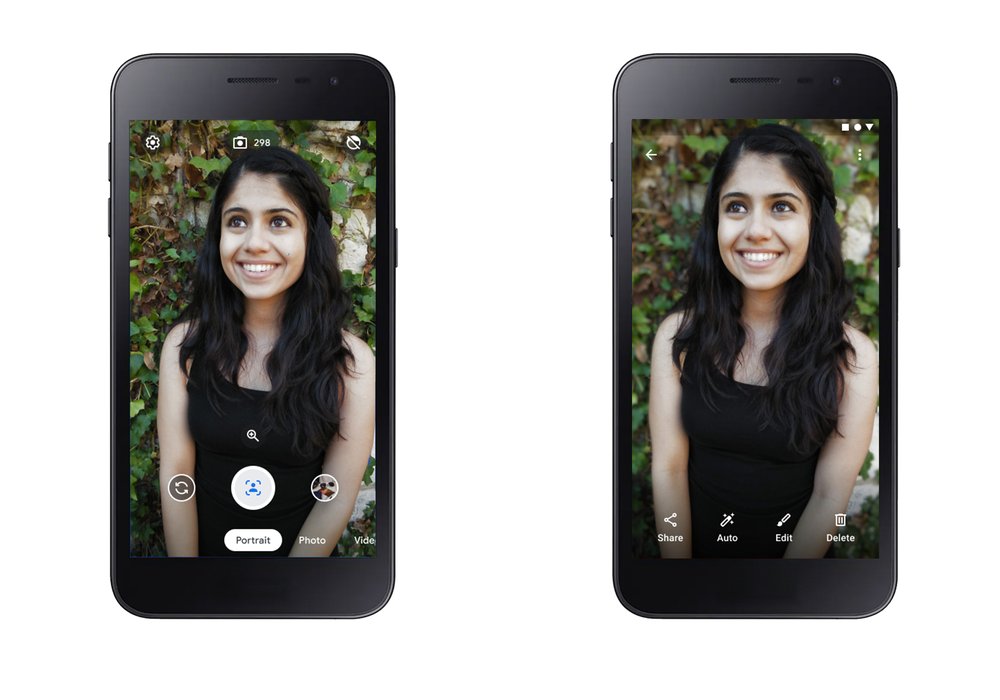
The new Camera Go app from Google helps you take beautiful photos without worrying about speed or storage. It has features like Portrait Mode to give your photos a professional look by focusing on your subject. It’s built for people using smartphones for the first time, so it has a clean and simple interface. And, most importantly, Camera Go tracks how much photo and video storage space you have left, and then it helps you clear up space so you never miss a shot.
Camera Go will be available on Nokia 1.3 and more Android (Go edition) devices soon.
Source: Android
Bringing more people online and introducing Camera Go
There are more than 3.5 billion people who use smartphones, but that’s only 45 percent of the world’s population. We created Android (Go edition) to bring more affordable, high-quality smartphones to people around the world. Thanks to our partners who have made more than 1,600 device models available in 180+ countries, there are now more than 100 million active Android (Go edition) devices around the world. Here are some updates on Go edition’s progress and where we’re going next.
Powering universal access to information
In partnership with Safaricom, Kenya’s largest telecom provider, we brought more than 900,000 Android (Go edition) smartphones to people in Kenya—53 percent of whom were women—through their “Life is Digital” campaign. This is especially important because there is a significant gender gap in mobile internet usage in Sub-Saharan Africa.
With the help of the suite of Google apps designed for Go edition, people are connecting with new opportunities and making gains in their daily lives. For example, Google Go has helped connect millions of people to information by providing a lightweight search engine that works on unstable connections. And with Lens in Google Go, people can quickly translate, hear and search text they see in the real world using their phone camera—helping them understand words on street signs, medicine labels, documents, and more.
Across the Google apps designed for Android (Go edition), we’ve introduced a number of user privacy features to protect the next billion people coming online for the first time. For example, a new mode within Google Go lets people search without their searches being saved to their account, and Gallery Go leverages on-device machine learning to help people organize photos without ever sending data to the cloud.
Bringing a beautiful, fast camera experience to affordable devices
Your phone’s camera gives you the power to capture memories that you’ll want to share with those around you. But on many smartphones, camera apps are often slow or complex to use, and your phone can quickly run out of storage.

The new Camera Go app from Google helps you take beautiful photos without worrying about speed or storage. It has features like Portrait Mode to give your photos a professional look by focusing on your subject. It’s built for people using smartphones for the first time, so it has a clean and simple interface. And, most importantly, Camera Go tracks how much photo and video storage space you have left, and then it helps you clear up space so you never miss a shot.
Camera Go will be available on Nokia 1.3 and more Android (Go edition) devices soon.
Source: Android
Google Translate adds five languages
Millions of people around the world use Google Translate, whether in a verbal conversation, or while navigating a menu or reading a webpage online. Translate learns from existing translations, which are most often found on the web. Languages without a lot of web content have traditionally been challenging to translate, but through advancements in our machine learning technology, coupled with active involvement of the Google Translate Community, we’ve added support for five languages: Kinyarwanda, Odia (Oriya), Tatar, Turkmen and Uyghur. These languages, spoken by more than 75 million people worldwide, are the first languages we’ve added to Google Translate in four years, and expand the capabilities of Google Translate to 108 languages.
Translate supports both text translation and website translation for each of these languages. In addition, Translate supports virtual keyboard input for Kinyarwanda, Tatar and Uyghur. Below you can see our team motto, “Enable everyone, everywhere to understand the world and express themselves across languages,” translated into the five new languages.

If you speak any of these languages and are interested in helping, please join the Google Translate Community and improve our translations.
Source: Translate
Google Translate adds five languages
Millions of people around the world use Google Translate, whether in a verbal conversation, or while navigating a menu or reading a webpage online. Translate learns from existing translations, which are most often found on the web. Languages without a lot of web content have traditionally been challenging to translate, but through advancements in our machine learning technology, coupled with active involvement of the Google Translate Community, we’ve added support for five languages: Kinyarwanda, Odia (Oriya), Tatar, Turkmen and Uyghur. These languages, spoken by more than 75 million people worldwide, are the first languages we’ve added to Google Translate in four years, and expand the capabilities of Google Translate to 108 languages.
Translate supports both text translation and website translation for each of these languages. In addition, Translate supports virtual keyboard input for Kinyarwanda, Tatar and Uyghur. Below you can see our team motto, “Enable everyone, everywhere to understand the world and express themselves across languages,” translated into the five new languages.

If you speak any of these languages and are interested in helping, please join the Google Translate Community and improve our translations.
Source: Translate
Google for Argentina: more opportunities through tech
A couple of weeks ago at Google for Argentina, we shared how Google has opened up opportunities and a path for growth for people and businesses in Argentina. Here’s what we highlighted at the event:
Our impact in Argentina
In 2018, Google contributed to the national economy with more than 52 billion Argentinian pesos, helping more than 30,000 companies, publishers, media and nonprofit organizations across the country generate income.
Small and medium businesses (SMEs) are an important part of the national economy, yet only 52 percent of Argentine SMEs have a website, which is essential to stand out online, find new customers, and grow their businesses. Google for Small Businesses is a new website that brings together Google tools designed for small and medium businesses.
Get around faster with Google Maps
To improve the mobility of all Argentines, we launched two-wheeler mode in Google Maps. The new feature helps motorcyclists move around the country faster and more efficiently. To help people with their commutes, we also brought bike routes and information about bus routes—like departure and arrival times—to Maps.
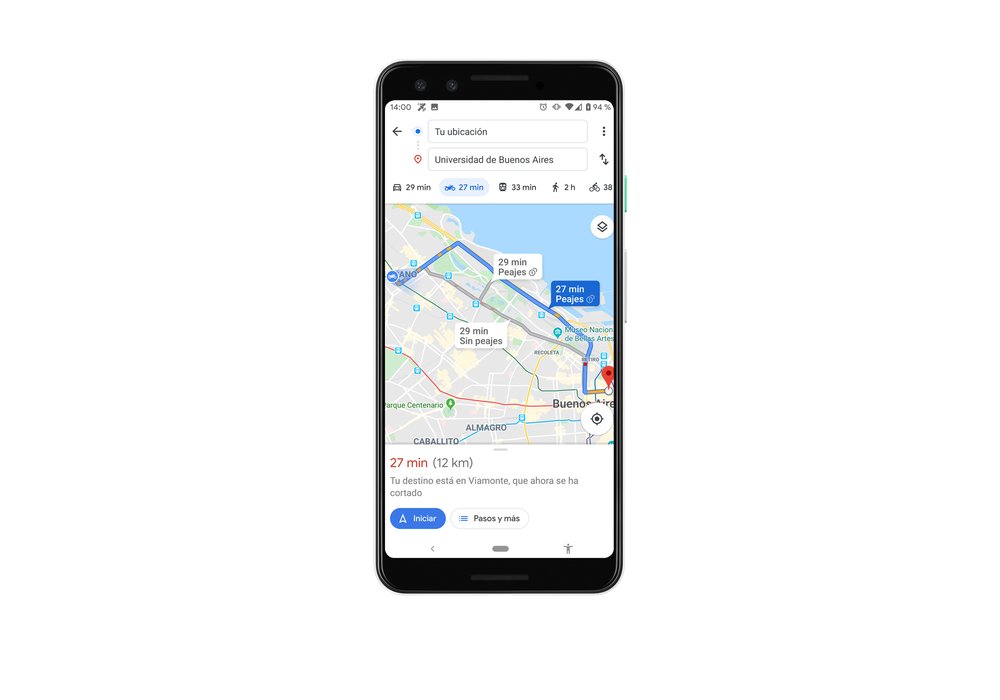
New features in the Assistant
The Google Assistant helps millions of people with daily needs just by saying, "Ok, Google." In early 2020, Argentines will be able to use the Google Assistant to make faster payments through platforms such as Mercado Pago. You can also use the Assistant to play games with your family. Etermax’s Trivia Game (“Ok Google, jugar preguntados”) is a new version of the popular “Trivia Crack” game, and "The Children's Kingdom includes new songs, riddles and stories from the popular YouTube channel.
Laying cables
This year, we announced the future extension of the Tannat submarine cable, which currently connects Brazil with Uruguay. This extension process, which will be carried out with Antel, a telecommunications company in Uruguay, will take the cable to Las Toninas, on the Argentine coast, where most of the submarine cables that reach the country are connected. The extension of the Tannat cable marks a new milestone in Argentina's technological development and will allow us to improve connectivity to Google's services and products.Privacy updates
Security and privacy are essential for Google, and the privacy features announced at Google I/O in May are now available in Argentina. You can now quickly access privacy settings in products like Search, Maps, the Assistant and YouTube, and choose whether to automatically delete the activity log in your Google Account.
Investing in digital tools for everyone
In 2017, we brought Grow with Google to Argentina, where we held a digital skills training for entrepreneurs, women, SME owners, teachers and young job seekers. Grow with Google has visited 10 cities in the last three years, training more than 100,000 people in 2019, and more than 220,000 people since its launch.
IT Support Certificate is another part of our digital skills work. It’s an online program that prepares people for IT support roles in under six months. Google.org awarded $500,000 to Junior Achievement so that 500 low-income young Argentines could able to enroll in the program and develop IT and job preparation skills.
Sustainable and quality journalism
The Google News Initiative strengthens collaboration with the media throughout the country, allowing for innovation in their newsrooms, development of new business models and high-quality of their content.Six Argentine media organizations are among the 30 Latin America winners in the GNI Innovation Challenge. They’re developing projects that will move digital news forward, and will each receive up to $250,000.
Google for Argentina was a great opportunity to show our commitment to businesses and the people who use our products. Working together, we’ll find new ways to use technology to succeed.
Source: The Official Google Blog
mPaani raises Series A from connections made at Google’s accelerator
Google Developers Launchpad is an accelerator program that excels in helping startups solve the world’s biggest problems through the best of Google, with a focus on advanced technology. However our impact doesn’t stop there. A distinguishing aspect of our program is the network that we build with, and for, our founders. Over the past five years, Launchpad has created a global community of founders based on deep, genuine connections that we foster during the program, and that community supports one another in remarkable ways.
When Akanksha Hazari Ericson, Launchpad alumna and founder of m.Paani, took the stage at Google Developers Launchpad Future of Finance Summit in March, she didn’t know what would come of it. Fast forward, she just announced a Series A financing round, led by an institutional venture investor who was in the audience and two of her fellow founders in the Launchpad Accelerator program.
“We weren't even raising at the time,” said Akanksha. “They saw our Future of Finance presentation and engaged with me right after my talk. Soon after, they were on a flight to Mumbai to meet our team and customers. Their investment initiated this round.”
The peer investment came from Launchpad alumni, and angel investors, Kevin Aluwi, CEO and Co-Founder, and Ryu Suliawan, Head of Merchants at GO-JEK, a Southeast Asian on-demand, multi-service platform and digital payment technology group. Both Kevin and Ryu saw direct value in what m.Paani and have stated their excitement to be part of m.Paani’s journey. They also saw huge strategic potential for the company to empower local retailers beyond India.
“It is because of the strong community of founders that Launchpad creates that I was able to make these amazing friends and mentors. Those connections led to this investment,” Akanksha said. “These investors have strategic relevance and add immense value to our business.”
m.Paani’s product uses machine learning technology, powered by Google Cloud, to empower more than 60 million family-owned local businesses in India by providing them with an online store front. The vast majority of local retailers are not digitized in any way; m.Paani’s solution allows them to compete with an app & web store, ability to accept digital payments, create loyalty programs, and much more.
m.Paani, who attended the Launchpad Accelerator in 2019, is now part of a wider community of Launchpad founders and companies that spans almost 400 startups across the world.

"It's exciting to watch startups grow, but it's even more exciting when investment comes through the resources and connections we helped foster as part of the program,” said David McLaughlin, Director of Google Developers Ecosystem team. “We put on strong focus on founder-to-founder interaction in our curriculum, mostly via our Leaders Lab and Growth Lab. We really want to create a wider community of founders who are willing to support each other. To see m.Paani take the next step on the funding ladder through that community showcases one of the many benefits for founders who join us for this accelerator".
Akanksha, and her team, are excited about how the funds will help scale the offering for local retailers. “The funding will allow us to grow quickly, invest in product and technology, and better serve our retailers. Our retail partners are the backbone of our local economy and culture, and deserve the ability to compete in the digital age. This, more than anything else, is what gets me and our whole team up and excited every morning.”
Want to learn more about Akanksha’s founder journey with m.Paani? Check out her story here.
Source: Google Developers Blog
More improvements for Android on entry-level phones
In many places in the world, entry-level smartphones are often the first and only way people get access to the internet. As we build Android for everyone, making sure that these devices are affordable and high quality is a top priority. That’s why we launched Android (Go edition) in 2018—a platform tailored for smartphones with 1.5GB of memory or less. As we release Android 10 (Go edition), here's a look at how we're making experiences for entry-level device owners better, across the platform and apps.
Android 10 (Go edition)
With Android 10 (Go edition), we've made Android faster and more secure.
First, this new release helps you switch between apps faster and in a memory-efficient way. Speed and reliability are also enhanced—apps now launch 10 percent faster than they did on Android 9 (Go edition).
Encryption underpins our digital security, as it protects your data even if your device falls into the wrong hands. That’s why Android 10 (Go edition) includes a new form of encryption, built by Google for entry-level smartphones, called Adiantum. Up until now, not all entry-level smartphones were able to encrypt data without affecting device performance.
Adiantum is built to run efficiently without specialized hardware, meaning all Go edition users will have the same level of data security as any Android device, without compromising performance. This will make the next generation of devices more secure than their predecessors, and allow the next billion people coming online for the first time to do so safely.
Keep an eye out for the new phones with Android 10 (Go edition) launching later this fall.
New app experiences
Apps designed for Go edition phones are also improving to better serve the needs of first-time smartphone owners.
For example, we’ve introduced a number of updates to Google Go. With the AI-powered read-out-loud feature that makes consuming long-form text as easy as listening to the radio, people feel more comfortable using the web in their daily lives. Lens in Google Go helps people who struggle to read things in real life by reading out and translating the text that you point with your camera. Since the launch, people have told us that it helps them read and understand important things like bus schedules and bank forms.
YouTube Go, which helps people watch videos on low-speed connections, is also receiving positive responses. People tell us they encounter less buffering while streaming videos, and are now saving on their data consumption.
The new Gallery Go by Google Photos makes it easier to find photos on your entry-level phone. Just 10MB in size and powered by on-device machine learning, it automatically organizes your photos by the people and things you take photos of—and it works offline, too.
Across the ecosystem, more Android developers are now enhancing their apps to work well on Android (Go edition) devices. In the past year, popular apps like Uber, Facebook Messenger, Twitter, and Spotify have been redesigned to be Go-ready. If you’re a developer, visit our developer site to learn how to build for the next billion.
Go for everyone
In the last 18 months, over 500 manufacturers have launched more than 1,600 Android (Go edition) device models to 180+ countries including India, South Africa, Nigeria, Brazil, and the United States. These devices, including the Samsung A2, Xiaomi Redmi Go, Tecno Spark 2, and Mobicel Astro, make up over 80 percent of entry-level Android phones activating today.
In some countries, devices are now available for as low as $27. Whether it comes with a high-definition or regular display, 4GB or 16GB of storage, or 3G or 4G support, there’s a Go edition device for everyone.
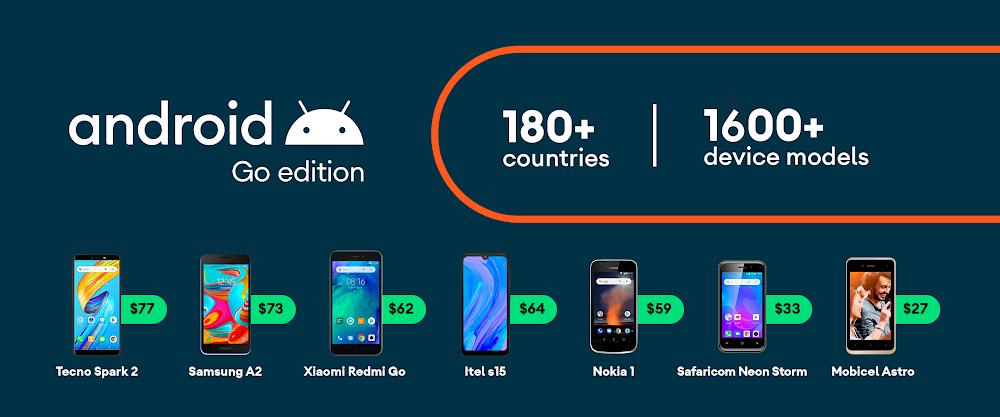
With the new platform release and more app choices, Android (Go edition) brings a broader range of options and better performing phones to more people coming online for the first time.
Source: The Official Google Blog
A more accessible internet for Indians
Rama Devi has taught more than a thousand women how to use the internet in her role as a saathi—now she’s helping farmers become more productive. Amita Raghu has used digital tools to grow Krishne Tassels, her traditional saree tassel business, and trained 700 women in the art of tassel-making. Rajesh Jain, winner of Google’s AI Impact Challenge, has created an app that helps cotton farmers identify pests just by snapping a photo.
These are some of the more than 460 million Indians using the internet to search, create, solve problems, build businesses—and help others. They show how technology isn’t just driving economic growth in India, but creating a ripple effect of opportunity across communities.
Continuing that momentum was the focus of this year’s Google for India event, where we shared announcements aimed at making the internet more accessible, inclusive and empowering for Indians.
Expanding reliable Wi-Fi in India
Four years ago, we launched Google Station: a partnership with Railtel and Indian Railways to bring fast, reliable and secure WiFi to 400 train stations. We hit that milestone last May, and we’ve also expanded the program beyond train stations to include thousands of public buildings and spaces around the country. Today we announced the next step: a partnership with BSNL to bring high-speed public WiFi to villages in Gujarat, Bihar and Maharashtra—places that haven’t had a WiFi connection before.
We also announced an initiative to help the hundreds of millions of Indians who use 2G phones get the information they need, without requiring data or an internet connection. The Vodafone-Idea Phone Line—supported by the Google Assistant—enables Vodafone-Idea users to call a single number (000 0800 9191000) free of charge at any time, and ask for everything from sports scores, traffic conditions and weather forecasts to help with homework. The service will be available across India in English and Hindi.
Speaking India’s languages
As we improve access to the internet, we also need to make it relevant and helpful, with information Indians need in the languages they speak.
For many Indians, searching by voice rather than text is their first choice. Two years ago, we introduced voice search in nine Indian languages on Google Assistant. Hindi is now the second-most used Assistant language globally after English. And from today, you can simply say, "Hey Google, talk to me in Hindi” (or the Indian language of your choice) to start using the Assistant, without needing to dig around in settings.
We’re also adding more Indian languages to the Google apps Indians use, including Discover, Lens and Bolo (an AI-powered teaching app that’s already helped 700,000 young Indians learn to read).
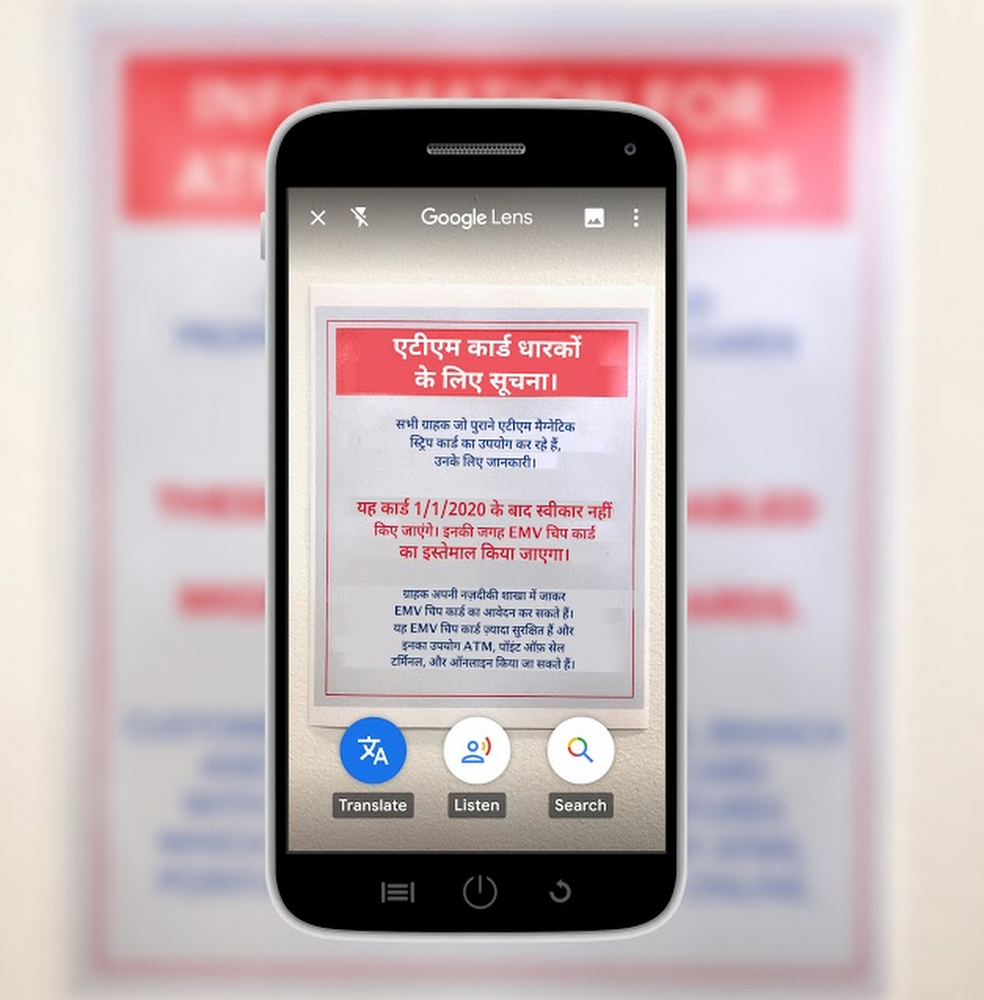
Building platforms for economic opportunity
One of the biggest factors in India’s booming internet economy has been the rise of digital payments—from 17 million transactions in August 2017 to more than 900 million last month.
We launched Google Pay to support this growth, giving Indians a fast, safe and reliable way of making and receiving payments. It’s now used by millions of people to complete transactions with hundreds of thousands of offline and online merchants. But we think there’s an even bigger role for Google Pay as a tool to support small businesses.
Starting today, we’re introducing the Spot platform: a way for businesses to create experiences and engage their customers within the Google Pay app. Popular services like UrbanClap, Goibibo, MakeMyTrip, RedBus, Eat.Fit and Oven Story are already on board through our early access program, and we’re excited to see how other organizations use Spot to make life easier and more convenient for the Indians who rely on them.
We’re deepening our support for small businesses through a new app called Google Pay for Business: a free and easy way for small merchants and storefronts to enable digital payments without the hassle of time-consuming verification process. And we’re stepping up our support for job seekers too - introducing a Spot on Google Pay to help people find entry level positions that aren’t always easily discoverable online. We’ll be partnering with the National Skill Development Corporation to make sure Skill India students can take advantage of it.
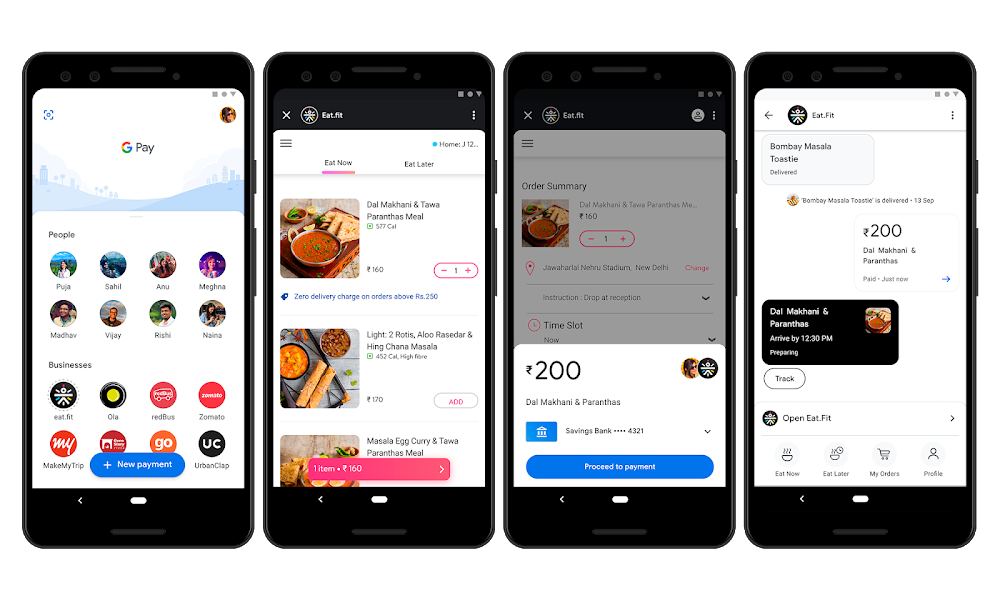
Merchants can use Spot on Google Pay to provide a better customer experience.
These are just some of our efforts to help more Indians share in the benefits of the internet economy, and we’re looking forward to continuing to contribute to India’s extraordinary progress and growth.
Source: The Official Google Blog
How m.Paani seeks to boost 60 million Indian retailers
There are more than 60 million family-owned local businesses in India, that drive more than 90 percent of retail in the country. They also account for more than 40 percent of local employment. Until recently, these retailers have enjoyed a consistent customer base for generations with little competition. Now, a billion Indians are coming online and there is a new digitally-driven Indian consumer to serve. With competition from new formats from e-commerce to big box stores, local retailers are presented with a new set of challenges that could put many of them out of business and leave a large portion of the population unemployed.
Akanksha Hazari Ericson is using technology to provide a solution. The vast majority of local merchants in India are not digitized in any way. Akanksha’s startup, m.Paani, is empowering them with the tools to survive and thrive. The startup is currently working in India, and eventually plans to expand across other emerging markets. m.Paani was recently part of Google Developers Launchpad Accelerator, a program that supports startups with access to Google technology, mentorship, and network.
From running seven acceleration programs around the world and supporting 341 startup founders, Launchpad has seen firsthand how global entrepreneurs are using technology and innovation to solve the world’s biggest problems. As part of our “Ideas to Reality” spotlight series, we caught up with Akanksha to talk about her journey in starting m.Paani and where she sees the company going over the next few years.
When did you realize your mission to help local retailers?
I got the entrepreneurial bug when I successfully built and grew my first venture at 21. I then decided that my next business would be built in India, contributing to the country’s economic development, and eventually other emerging markets as well. In 2009, I returned to India after completing my masters at Cambridge to work in the intersection of tech and agriculture. I spent a year living in villages across the country, looking at how we can use technology to increase farmers’ incomes. This is when I also fell in love with the local businesses with which I interacted, and realized the critical role they play in our economy. The beginnings of m.Paani were born.
What is the first step you take when you turn your idea into a reality?
Understand and build a relationship with my customer. I moved to Mumbai, a city in which I had never lived and knew no one, with a presentation and a dream. Walking the local markets every day, I signed up and sold our product to our first 50 retailers and a few hundred consumers myself. I strongly believe that if you don’t know your customer directly and can’t sell your vision, solution or service to them at the beginning, then you are in no position to ask anyone else to do so.
Are there Google products you are using and would recommend to other startup founders?
Yes, three core products help us run our business. First, we’re hosted on Google Cloud. Next, we’re using Firebase for event tracking, testing and marketing. We love the flexibility that Firebase gives us to keep being nimble. Finally, we use Google Analytics, which is an absolute must for any business and a pivotal part of each day.
Tell us more about your experience in Launchpad Accelerator.
If you have to learn, you might as well learn from the best. Launchpad has given us great insights, especially in machine learning. The one-to-one mentorship session with Peter Norvig, Google’s machine learning director, was a standout moment for our team. The entire experience was truly enriching and would recommend it to any entrepreneurs.
What advice do you have for future entrepreneurs?
Find a very very big, meaningful problem to solve. Something that has a deeper purpose for you, and makes our world a better place. It is more important than ever now that we all look to solve real problems in the world, from sustainability to economic empowerment. Don’t expect it to be glamorous—at all. Expect it to be unfathomably hard, and expect yourself to be more tenacious and resilient than you have ever been. But trust me, because it is purpose-driven you will stay motivated, and if you stick with it until its solved, you will change the world.
What is the most inspiring part of your work?
Our retailers. These are family businesses built over generations, in some cases. My favorite part of my job is meeting our customers and learning from them. The most meaningful part of any day is hearing and seeing first hand our positive impact on empowering, transforming and growing a local business. This, more than anything else, is what gets me and our whole team up and excited every morning.